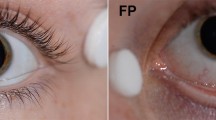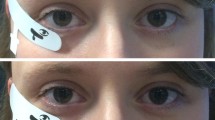Abstract
Purpose
The DTL fibre electrode is commonly used to record the electric potentials elicited by stimulation of the retina. Two positions are commonly used: it is placed either on the cornea along the lower lid or in the conjunctival fornix. The PERG and OPs have previously been examined and compared under both conditions. The aim of this study was to examine the ERG, flicker response and on–off responses with differing electrode positions.
Methods
Before recruitment, all subjects underwent an ophthalmological examination. We enrolled 13 normal control subjects into the study aged 13–64 years, all with a visual acuity of ≥1.0. We recorded scotopic and photopic ERGs, flicker and on–off responses, for both electrode positions. On the first day, one eye had the electrode placed on the cornea along the lower lid and the other eye had it positioned in the conjunctival sac. On a second day, the recordings were repeated with the alternative electrode placements.
Results
ERG, on–off and flicker responses were all smaller by between 20 and 25% when the DTL electrode was positioned in the conjunctival sac, compared to when it was positioned on the cornea, as did the scatter in the data points. This indicates that there is no advantage clinically for one or the other placement.
Conclusions
Our results confirm other reports examining the effect of electrode position on electrophysiological potentials. When recording with the DTL electrode, it is important to ensure that it is placed at the same position in repeat recordings or in multicentre trials and that it is stable and does not move during recording.



Similar content being viewed by others
References
McCulloch DL, Marmor MF, Brigell MG, Hamilton R, Holder GE, Tzekov R, Bach M (2015) ISCEV standard for full-field clinical electroretinography (2015 update). Doc Ophthalmol 130(1):1–12. doi:10.1007/s10633-014-9473-7
Mentzer AE, Eifler DM, Montiani-Ferreira F, Tuntivanich N, Forcier JQ, Petersen-Jones SM (2005) Influence of recording electrode type and reference electrode position on the canine electroretinogram. Doc Ophthalmol 111(2):95–106. doi:10.1007/s10633-005-4517-7
Dawson WW, Trick GL, Litzkow CA (1979) Improved electrode for electroretinography. Invest Ophthalmol Vis Sci 18(9):988–991
Thompson DA, Drasdo N (1987) Computation of the luminance and pattern components of the bar pattern electroretinogram. Doc Ophthalmol 66(3):233–244
Mierdel P (1995) An improved holder for the DTL fiber electrode in electroretinography. Doc Ophthalmol 89(3):249–250
Krakau CET (1958) On the potential field of the rabbit electroretinogram. Acta Ophthalmol 36(2):183–207. doi:10.1111/j.1755-3768.1958.tb07707.x
Honda Y (1977) Some characteristics of the c-wave of ERGs recorded by a pair of electrodes on the cornea and sclera. Albrecht von Graefes Archiv für klinische und experimentelle Ophthalmologie 202(1):19–26. doi:10.1007/BF00496765
Doslak MJ, Plonsey R, Thomas CW (1980) The effects of variations of the conducting media inhomogeneities on the electroretinogram. IEEE Trans Biomed Eng 27(2):88–94. doi:10.1109/TBME.1980.326712
Cringle SJ, Alder VA, Brown MJ, Yu DY (1986) Effect of scleral recording location on ERG amplitude. Curr Eye Res 5(12):959–965
Otto T, Bach M (1997) Reproducibility of the pattern electroretinogram. Ophthalmologe 94(3):217–221
Lachapelle P, Benoit J, Little JM, Lachapelle B (1993) Recording the oscillatory potentials of the electroretinogram with the DTL electrode. Doc Ophthalmol 83(2):119–130
Rotenstreich Y, Fishman GA, Anderson RJ, Birch DG (2003) Interocular amplitude differences of the full field electroretinogram in normal subjects. Br J Ophthalmol 87(10):1268–1271
Bland JM, Altman DG (1986) Statistical methods for assessing agreement between two methods of clinical measurement. Lancet 1(8476):307–310
Holm S (1979) A simple sequential rejective multiple test procedure. Scand J Stat 6:65–70
Fishman G, Birch D, Holder G (2001) Electrophysiologic testing in disorders of the retina, optic nerve, and visual pathway, 2nd edn. The Foundation of the American Academy of Ophthalmology, San Francisco
Hebert M, Lachapelle P, Dumont M (1996) Reproducibility of electroretinograms recorded with DTL electrodes. Doc Ophthalmol 91(4):333–342
Hebert M, Vaegan Lachapelle P (1999) Reproducibility of ERG responses obtained with the DTL electrode. Vis Res 39(6):1069–1070
Kothe AC, Lovasik JV, Coupland SG (1989) Variability in clinically measured photopic oscillatory potentials. Doc Ophthalmol 71(4):381–395
Funding
The study was supported by Grants from the Erasmus + Programme and the German Ophthalmological Society (DOG) to HL.
Author information
Authors and Affiliations
Corresponding author
Ethics declarations
Conflict of interest
All authors certify that they have no affiliations with or involvement in any organization or entity with any financial interest (such as honoraria; educational grants; participation in speakers’ bureaus; membership, employment, consultancies, stock ownership, or other equity interest; and expert testimony or patent-licensing arrangements), or non-financial interest (such as personal or professional relationships, affiliations, knowledge or beliefs) in the subject matter or materials discussed in this manuscript.
Statements of human rights
All procedures performed in studies involving human participants were in accordance with the ethical standards of the institutional and/or national research committee and with the 1964 Declaration of Helsinki and its later amendments or comparable ethical standards.
Statement on the welfare of animals
This article does not contain any studies with animals performed by any of the authors.
Informed consent
Informed consent was obtained from all individual participants included in the study.
Rights and permissions
About this article
Cite this article
Kurtenbach, A., Kramer, S., Strasser, T. et al. The importance of electrode position in visual electrophysiology. Doc Ophthalmol 134, 129–134 (2017). https://doi.org/10.1007/s10633-017-9579-9
Received:
Accepted:
Published:
Issue Date:
DOI: https://doi.org/10.1007/s10633-017-9579-9




